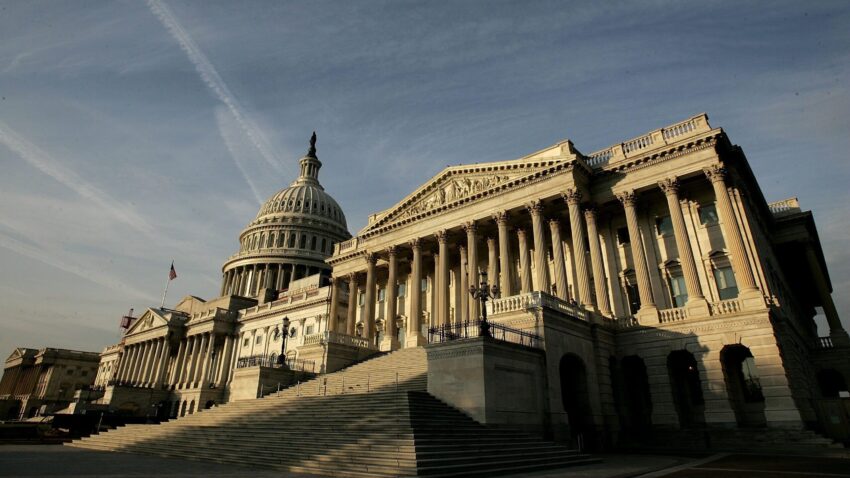The early morning sun strikes the U.S. Capitol November 6, 2006 in Washington, DC. (Photo by Win McNamee/Getty Images)
WASHINGTON — The Pentagon hasn’t released the full version of its fiscal 2026 budget request, but that’s not stopping the House Appropriations Committee, which today put forth its own $831.5 billion draft defense spending bill.
The bill includes discretionary spending for defense that is flat compared to the full year continuing resolution enacted for FY25 — equivalent to the amount that the White House signaled it would request for FY26. Additional money from the yet-to-be passed One Big Beautiful Bill could potentially boost defense spending past the $1 trillion mark in FY26.
The FY26 defense appropriations bill, together with the reconciliation money, represents “a historic commitment to strengthening and modernizing America’s national defense,” said Rep. Ken Calvert, R-Calif., who chairs the House Appropriations defense subcommittee.
The committee’s bill contains $13 billion for missile defense and space programs that could integrate with the Golden Dome missile shield, one of the Trump administration’s top priorities, which could see $25 billion in additional spending if the reconciliation bill is passed. House appropriators’ investments in Golden Dome included about $8.8 billion for Missile Defense Agency programs and $4.1 billion for Space Force programs.
In a rebuke of the Army Transformation Initiative, lawmakers added dollars back to several procurement lines the service wants to end, including the Improved Turbine Engine Program (ITEP), the Joint Light Tactical Vehicle (JLTV) and Gray Eagle drones.
Procurement of the F-35 Joint Strike Fighter stayed relatively flat compared to FY25, with a total of $8.5 billion for 69 F-35 fighters, that includes 42 F-35As, 14 F-35Cs and 13 F-35Bs. The bill also includes $500 million for four KC-130Js for the Navy Reserve and $261 million for two C-130Js.
House appropriators signaled continued support for Pentagon initiatives meant to bring about increased technological innovation, proposing a combined $1.3 billion for the Defense Innovation Unit (DIU), Accelerate the Procurement and Fielding of Innovative Technologies (APFIT), and Office of Strategic Capital (OSC).
The bill also spends $2.6 billion for hypersonics programs across all the military services, with $806 million for continued development of the Navy’s Conventional Prompt Strike Program and $955 million for the Army’s Long Range Hypersonic Weapon (LRHW) making up the bulk of that investment.
The House Appropriations defense subcommittee will mark up the bill on Tuesday in a closed session, ahead of a public mark up by the full committee on Thursday. Here are the details:
Navy And Marine Corps
Overall, House appropriators set aside $36.9 billion for 28 ships, including six battle force ships: one Columbia-class ballistic missile submarine and two Virginia-class attack submarines — a break from FY25 when the committee supported funding only a single Virginia-class submarine — two Arleigh Burke-class destroyers, and one T-AGOS SURTASS ship for antisubmarine warfare. Absent, once again, is money to buy the first Constellation-class frigate requested by the Navy in FY25.
It also puts in $1.7 million for two T-AO fleet oilers, $225 million for one Medium Landing Ship for the Marine Corps and $320 million for two Ship-to-Shore Connectors.
The bill once again contains money meant to strengthen the maritime industrial base, with a total of $1.5 billion “to invest in critical areas including supplier capacity and capability, strategic outsourcing, workforce training, and technology and infrastructure,” $1.6 billion for “productivity enhancements” meant to increase shipbuilder capacity and efficiency at private nuclear shipyards, and $521 million to grow wages at the private nuclear shipyards.
In the realm of aircraft, the bill includes $1.2 billion for four E-2D Advanced Hawkeye aircraft for the Navy, $2 billion for 19 CH-53K helicopters for the Marine Corps, and $509 million for three MQ-25 Stingray tanker drones for the Navy. House appropriators also included $972 million to continue development for the Navy’s next-generation fighter program, known as F/A-XX, and $779 million for further development of the Navy’s E-130J Take Charge and Move Out (TACAMO) airplanes.
The bill also contains $795 million for 105 Amphibious Combat Vehicles for the Marine Corps.
Air Force
House appropriators intend to spend $3.8 billion to buy an unspecified number of B-21 Raiders, continuing the practice of keeping procurement numbers for the secretive bomber out of the public realm. It includes $2.7 billion for 15 KC-46 tankers. It also adds $474 million for two Compass Call Aircraft, countering the Air Force’s FY25 budget plans, which does not show any additional aircraft for FY26.
The committee also hopes to keep F-15EX procurement going with a purchase of three aircraft at a total of $345 million. The FY25 budget request shows no planned F-15EX procurement for FY26.
The bill spends $3.2 billion to continue development of the service’s sixth generation F-47 fighter and $602.3 million for VC-25B, more commonly known as the next Air Force One planes.
It also invests $1.8 billion for the Air Force’s Survivable Airborne Operations Center aircraft, $2.1 billion for the continued development of the B-21, and $500 million for development of the E-7 Wedgetail.
Army
The bill includes a sizable investment in Army rotorcraft, including $910.4 million for 29 UH/HH-60 Black Hawk helicopters, $680.2 million for 10 CH-47F Block II Chinook helicopters, and $360 million to support 12 remanufactured AH-64 Apache Block IIIA attack helicopters. It spends $240 million for eight MQ-1C Gray Eagle drones for the Army National Guard.
It also puts $938.5 million into the Future Long Range Assault Aircraft (FLRAA) program and $175 million into the Improved Turbine Engine Program (ITEP).
In the area of vehicle procurement, the bill contains $715 million for 36 sets of M109A7 Paladin Self-Propelled Howitzers and M992A3 Field Artillery Ammunition Support vehicles for the Army, and $724.5 million to upgrade 35 Abrams tanks to the M1A2 (SEP)v3 tank variant. Although the service wants to halt JLTV buys, the bill includes $345 million for 863 JLTVs for the Army and $169 million for 224 JLTVs for the Marine Corps.
It also includes $193 million for next generation weapon squad weapon (NGSW) and fire control systems, as well as $286 million for NGSW ammunition.
Space Force
Besides the investments in Golden Dome, the bill includes $2 billion to procure 11 space launch missions under the National Security Space Launch (NSSL) Phase 3 contract, as well as $680 million to procure two GPS IIIF spacecraft.
In the development world, appropriators included $3.9 billion for Missile Warning/Missile Tracking systems, including satellites in low, medium, and high orbits. The bill also contains $1.8 billion for jam resistant and wideband military satellite communications, including assured satellite communications for nuclear command and control, as well as $360 million for Global Positioning System (GPS) operational control segment, advanced spacecraft development, and jam resistant GPS user equipment.
It spends $7 billion on classified space programs.
Click this link for the original source of this article.
Author: Valerie Insinna
This content is courtesy of, and owned and copyrighted by, https://breakingdefense.com and its author. This content is made available by use of the public RSS feed offered by the host site and is used for educational purposes only. If you are the author or represent the host site and would like this content removed now and in the future, please contact USSANews.com using the email address in the Contact page found in the website menu.








